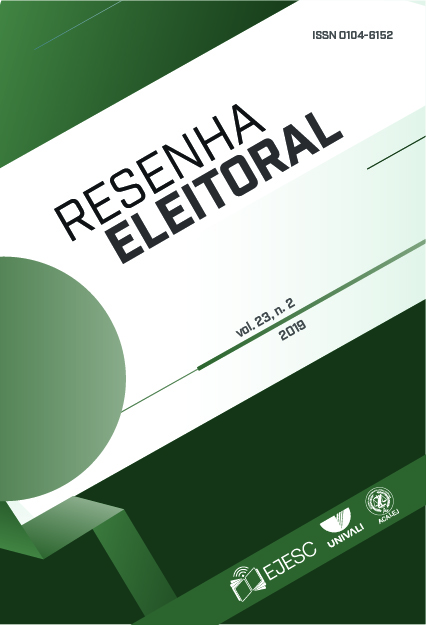The consequences of identifying fictitious candidacies: removal from office of the elected and disincentives to female representativity in politics
DOI:
https://doi.org/10.53323/resenhaeleitoral.v23i2.38Abstract
Based on the case study of the Municipality of Valença do Piauí/PI, this paper aims to analyze the consequences of fictitious female candidacies in a party or coalition. The perspective of the analysis takes into account the difficulty of the case leading case under discussion mainly because it involves the possibility of disqualification of elected candidates, regardless of any involvement in the mentioned fraud. To define consequences for affirmative action that did not come with a control system and whose effectiveness has been built up piecemeal is not an easy task. Far from it. There are countless questions unanswered: i) identified the fraud, what are the consequences of the action? ii) being ineligibility to run, to whom should it be impu- ted? iii) If the term of office of the elected is to be revoked, who shall be removed? iv) If women candidates are elected, considering that they are the recipients of affirma- tive action protection, should their terms be preserved? v) Opting for the disqualification of elected representatives, how should the va- cant seats be fulfilled? By recounting the votes or by holding new elections? The answers to these questions seek to, finally, identify how to make affirmative action effective without opposing more disincentive to the inclusion of women in politics.
References
ANDRADE NETO, J.; GRESTA, R. M.; SANTOS P. P. dos. Fraude à cota de gênero como fraude à lei: os problemas conceituais e procedimentais decorrentes do combate às candidaturas femininas fictícias. In: FUX, Luiz; PEREIRA, Luiz Fernando Casagrande; AGRA, Walber de Moura (Coord); PECCINI, Luiz Eduardo (Org.). Abuso de poder e perda de mandato. Belo Horizonte: Fórum, 2018 (Tratado de Direito Eleitoral, v. 7.).
DAHLERUP, D. El Uso de cuotas para incrementar la representación política de la mujer. In: MENDÉZ-MONTALVO, M.; BALLINGTON, J. Mujeres en el Parlamento. Más allá de los números. Estocolmo: International IDEA, 2002, pp.159-172.
GOMES, J. J. Direito Eleitoral. 12. ed. São Paulo: Atlas, 2016.
SACCHET, T. Partidos políticos e sub-representação feminina: um estudo sobre recrutamento legislativo e financiamento de campanhas no Brasil. In: PAIVA, D.; BEZERRA, H. D (Orgs). Mulheres, política e poder. Goiânia: Cânone Editorial, 2011.
SALGADO, E. D.; CALEFFI, R. Propostas para aumentar a participação feminina na política brasileira [on-line]. Mai. 2015. Disponível em: <http://www.conjur.com.br/2015-mai-02/propostas-aumentar-participacao--feminina-politica>. Acesso em: 14 ago. 2017.
SILVEIRA, M. de P. Responsabilidade eleitoral por ato de terceiro. Disponível em: http://www.oseleitoralistas.com.br/2013/03/18/os-ilicitos--eleitorais-praticados-por-terceiros-e-o-nexo-de-causalidade-para-responsabi-lizacao-do-candidato/Acesso em: 1 set. 2014.
Downloads
Published
How to Cite
Issue
Section
License
Copyright (c) 2019 https://creativecommons.org/licenses/by/4.0

This work is licensed under a Creative Commons Attribution 4.0 International License.
O(s) autor declara(m) que o trabalho é original e inédito, não tendo sido submetido à publicação em qualquer meio de divulgação, especialmente em outro periódico, nacional ou internacional, quer seja em parte ou na íntegra;
Caso aprovada e selecionada, fica autorizada a publicação da produção na Revista Resenha Eleitoral, a qual não se responsabiliza pelas opiniões, ideias e conceitos emitidos nos textos, por serem de inteira responsabilidade de seu(s) autor(es);
A publicação do artigo implica transferência gratuita dos direitos autorais à Revista, nas versões eletrônica e impressa, conforme permissivo constante do artigo 49 da Lei de Proteção de Direitos Autorais (Lei 9.610, de 19/02/98), e que a não observância desse compromisso submeterá o infrator a sanções e penas previstas no mesmo diploma legal;
Todos os artigos publicados são licenciados sob a Licença Creative Commons Attribution, que permite o compartilhamento do trabalho com reconhecimento da autoria e publicação inicial nesta revista.









